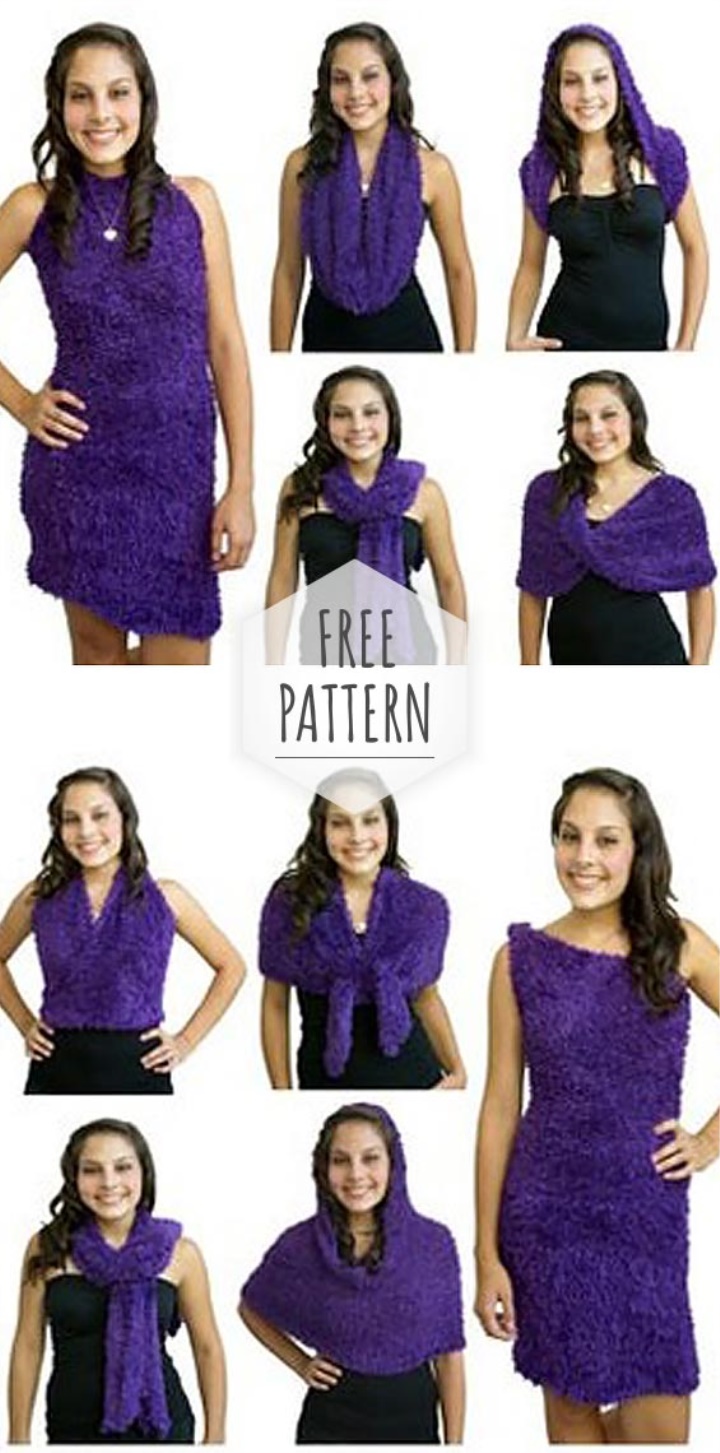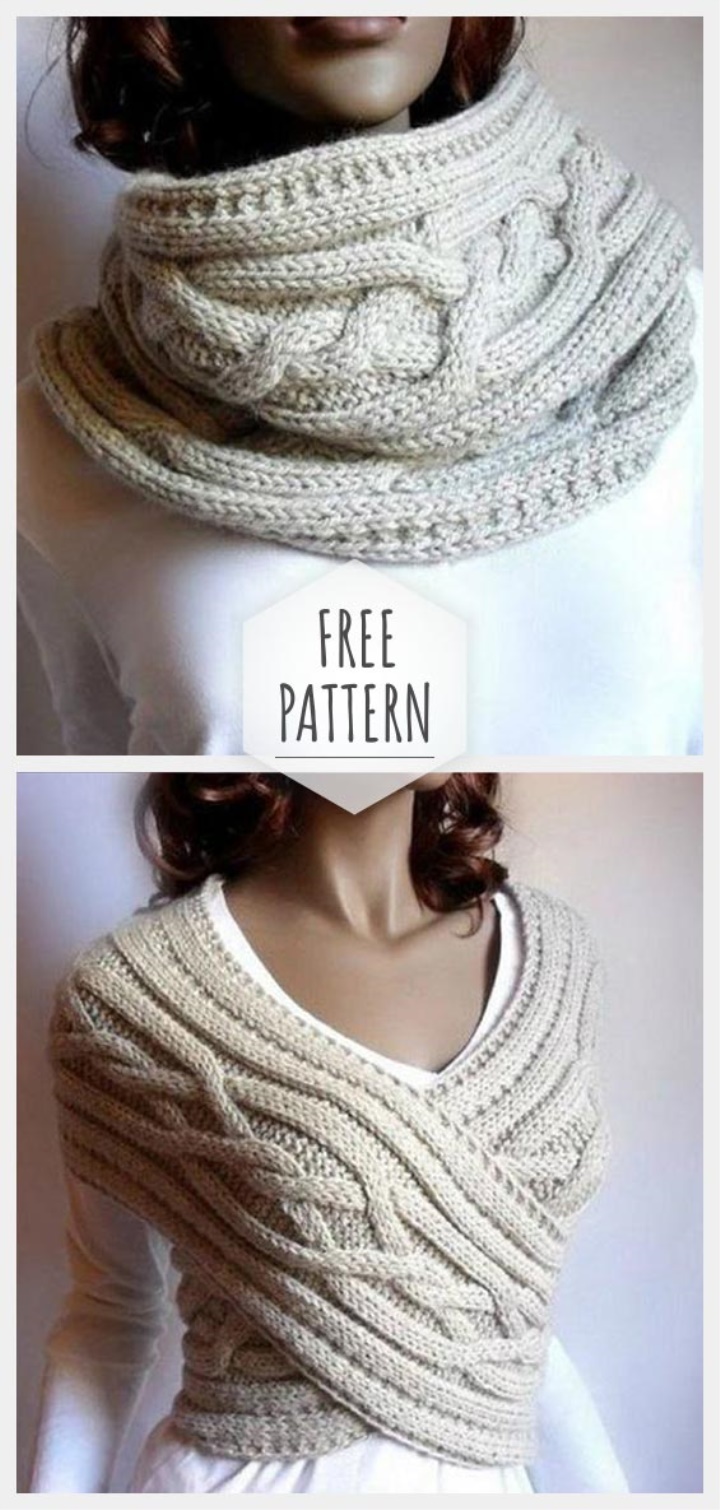About such an interesting accessory, as a scarf-transformer, have heard, perhaps, some years ago. and, of course, Few of whom he left Indifferent. This miracle accessory with one hand movement can easily transform... In cowl, dress, skirt, bolero, vest, cap-kapor... And more sea options, as far as you have enough imagination! They say that the scarf was invented by the japanese, and in this willingly believe, as the japanese, craftsmen on the most diverse and unusual inventions.
well, what fashionista will refuse such an accessory in her wardrobe, the more a scarf-transformer is able to replace half of things in this very wardrobe?
of course, Such a scarf can be bought, but it is very easy to tie and itself, it does not require any special skills. The main thing is to choose the right yarn so that the scarf stretches, but does not lose shape and Elasticity.
We will show you how to wear this miracle scarf, as well as give diagrams and descriptions that help to tie the original thing with your hands in just a couple of days!

How to tie a scarf-transformer: diagrams and descriptions
Option 1 (easiest)

You will need:
Yarn (choice):
-in the original scarf transformer made of "grass", 100% polyamide, 100 m for 50 gr-6 Motochkov
— Yarn of Tecno yarn Art – 100% polyamide, Microfiber 100 m/50g – 300 g
Circular SP. № 7;
Hook № 2.
Description
We dial on circular spokes of 100 loops, further it is necessary to knit by a face loops in a circle. The product will be of arbitrary length, it all depends on your parameters and Preferences. Finishing it, tying Kraeshki work with a hook-2 rows a column without a throw. This cowl spokes, made with his hands, perfectly stretches, so it can be used as kapor, dress, drape, cowl or waistcoat.
Option 2

You will need:
Yarn (70% wool, 25% acrylic, 5% polyamide, 65 m per 50 gr.) – 10 skeins;
Jv. № 3.5 (for KOS) and № 4;
Markers
Hook № 3.5.
The product knitted by spokes, ideally fit on the girl with 42-46 pp. Clothing.
Description
This model we will need to tie a pattern of braid ("aranov"). Such weaves give the product volume and the necessary Density.
We collect 100 loops, knit a scarf panel of the necessary size according to the following scheme:

The transformer scarf, knitted with his own hands, in the ready form should make 40 sm in width and 140-150 sm in Length. We will need loop markers to mark the extreme loops in Pigtails. Dress them up when we ARANA. Continue to knit according to the scheme, until the product reaches the required length, then the Scarf-transformer should be moistened, put on a flat surface and allow it to dry completely.
After drying, Obvjazyvaem the product with a hook on the front side of the columns without throwing in each loop. Then we only have to sew its edges, connecting in a Circle. You should roll the Scarf-transformer "eight" and put on, dropping one loop on the waist, and another-to spread on the Shoulders. If desired, it is possible to sew behind the bottom part of the upper "hinge" that lies on the shoulders, with the upper part of the bottom "loop" that is on the back, thus forming the original Vest.
Option 3 (scarf-jacket)

unusual, openwork, But at the same time quite warm-all this is about this beautiful accessory. If you carefully study the scheme and description, you can link it even a beginner mistress.
You will need:
cribbing (35% wool, 25% mohair, 23% merino, 10% angora, 7% polyamide, 95 m per 50 Gr.) – 10 motochkov;
Jv. № 6.
Platochnaja binding: Facial and purl rjaochki knit with facial loops.
The pattern of leaves and zigzags should be knit according to scheme 1:

In purl rows of P. It is necessary to knit on the given drawing, Nakidy make Purl. Start with edging P. and loops before rapportom, repeat rapport, finish p. After rapport and edging p., repeat the marked Rows.
Description
We dial for the sleeve of 40 loops, now we need to tie for the lath 3 rows Garter viscous, then continue the pattern of leaves and zigzags. After 15 SM = 30 rows from a lath we surcharge for bevels sleeves on both parties 1 p., in each eighth Rjadochke 3 x 1 p., in each fourth-10 x 1 P. and in each second p. 8 x 1. When the transformer scarf is ready, do not forget to close the loops, moisten the finished product and let it dry in a horizontal Position.
Option 4 (scarf-transformer with volumetric Braids)

warm, elegant and such a multifunctional scarf is ideal for autumn days!
You will need:
Yarn (50% angora, 50% acrylic, 100 m on 550 gr.) – 6 motochkov;
Jv. № 4.
The finished product will be 190 cm long and 45 cm wide.

Description
Before the beginning of knitting necessarily make calculation of loops, in our case their number will make 105 loops. Dialed on the narrow side of the future scarf loops distribute as Follows: 1 Chrome. p., 5 P. Garter viscous, 2 p. ipms. stitch, Braid of 24 pet., then 2 pet. IPMs. stitch, 37 Pet. Garter viscous (middle part), 2 pet. Knit Ipms. stitch, now again braid of 24 pet., 2 Pet. IPMs. stitch, now 5 p. Garter viscous and 1 chrome. P..
The number of loops in the middle part of the panel depends on the total number of loops, collected according to our preliminary calculations, and therefore it can vary: if we need to dial not 105 p., and on 100 p., then in the middle part will be not 37 p., and 32 p. (37 – 5 = 32). therefore, If we scored more 105-and loops, the redundant again aginst to the average 37-mi Petelkam.
It is also worth remembering that edge loops are better to bind the front, it will make the edge of the scarf neater, more ribbed and protect against rapid stretching and Deformation.
The main ornament of this neck-original relief braids-arana, for creation of which it is necessary to move on 3 pet. To the left or right according to the scheme using the auxiliary spoke.